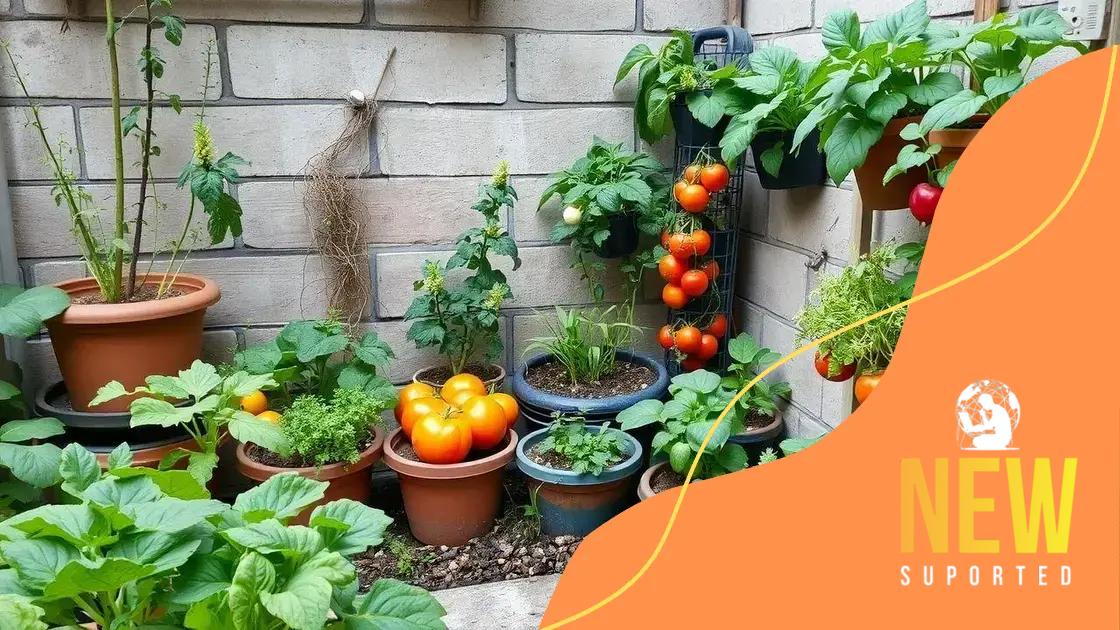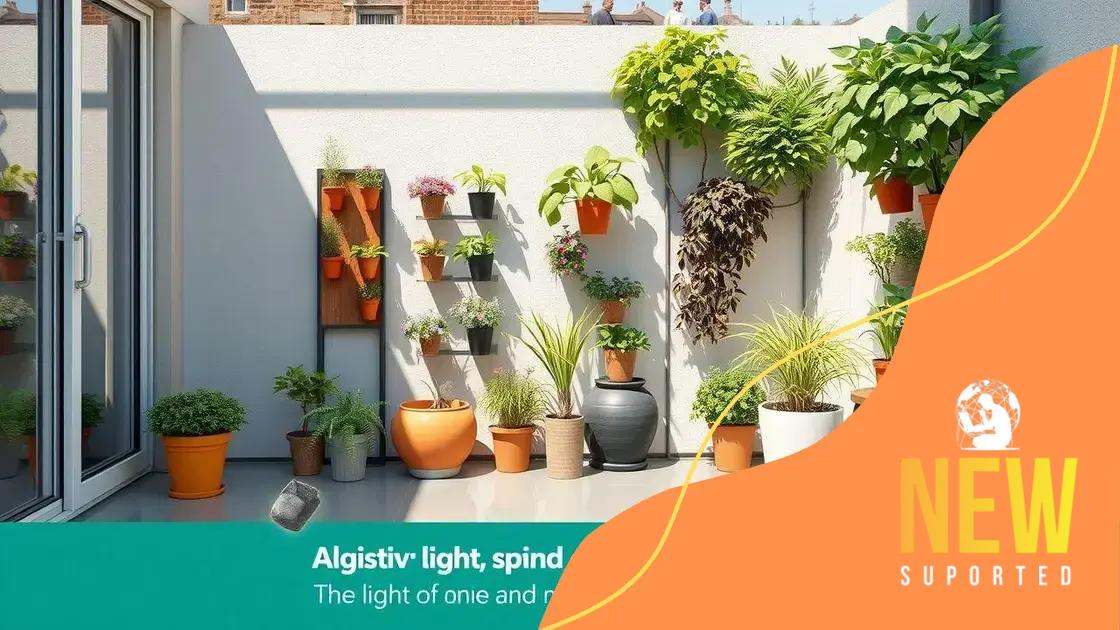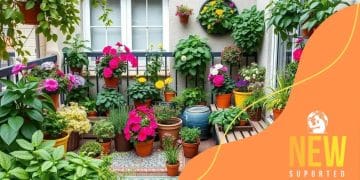How to grow your own vegetables in small garden spaces

To grow your own vegetables in small garden spaces, focus on container gardening, maximize light and space, and maintain consistent watering and pest control for healthy, productive plants.
How to grow your own vegetables in small garden spaces might sound challenging, but it’s quite achievable with the right approach. Have you ever imagined enjoying fresh produce right from your balcony or patio? Let’s dive into how you can make this dream a reality.
Choosing the right vegetables for small spaces
Choosing the right vegetables for small spaces is essential for a successful garden. Start by considering what you and your family enjoy eating most. This helps ensure that your gardening efforts yield delicious rewards. Whether it’s a cozy balcony or a tiny backyard patch, some vegetables thrive in limited areas.
Best Vegetables for Small Gardens
Several types of vegetables are perfect for small gardening spaces. Here are a few:
- Lettuce: Grows quickly and can be harvested multiple times.
- Radishes: Quick to mature and can tolerate tight planting.
- Herbs: Basil, parsley, and cilantro are easy to grow and add flavor.
- Cherry tomatoes: Compact and productive; perfect for containers.
Combining these vegetables in your garden can create a vibrant and useful harvest. Remember to rotate crops to keep the soil healthy. If you’re short on space, consider growing vertical crops like pole beans or cucumbers. They can climb structures, saving precious ground space.
Planning Your Garden Layout
When planning the layout of your small garden, think about sunlight and accessibility. Most vegetables need at least six hours of sunlight daily. Arrange taller plants on the north side so they don’t overshadow shorter ones. This allows every plant to thrive in its own space.
Don’t forget about companion planting. Pairing certain vegetables can improve growth and deter pests. For example, planting marigolds near tomatoes can help protect them from harmful insects. Be mindful of spacing; overcrowding can lead to competition for nutrients and water. If space is tight, consider using containers or vertical planters. Plants like lettuce and green onions can thrive in these setups. Additionally, using self-watering containers can help keep your plants hydrated with minimal effort.
Best gardening techniques for limited areas
When you have limited garden space, using the best gardening techniques can help you maximize your yield. Simple methods can make a big difference in your small garden. Understanding your methods can ensure healthy plants and a vibrant harvest.
Vertical Gardening
One effective way to use your space is through vertical gardening. This method allows you to grow plants upwards instead of outwards, saving valuable ground space. You can use trellises, wall planters, or even repurpose old pallets. This approach is perfect for climbing plants like cucumbers, peas, and tomatoes.
- Trellises: Great for beans and cucumbers.
- Wall planters: Perfect for herbs and small leafy greens.
- Pallet gardens: Useful for creating a layered garden.
Incorporating vertical gardening techniques opens new possibilities for your small garden. By having plants grow upwards, you can also improve air circulation and sun exposure, leading to healthier crops.
Container Gardening
Container gardening is another fantastic technique for small spaces. It allows you to grow vegetables almost anywhere. The key is to choose the right container sizes and materials, such as clay pots, plastic containers, or fabric bags. Ensure your containers have proper drainage.
Choose plants that thrive in containers. Some of the best choices include lettuce, radishes, and herbs. You can even plant a small fruit tree in a large pot. Caring for container plants is straightforward. Regular watering and the right soil mix will keep them healthy.
Additionally, consider using raised beds. They work well in limited spaces and improve soil quality. You can control soil depth and drainage easily. Raised beds can be built from wood, bricks, or stones, offering a sturdy structure for your plants.
Companion Planting
A great way to get more from your small garden is to practice companion planting. This technique involves planting different vegetables together to enhance growth and deter pests. Certain plants can benefit each other when grown in proximity.
For instance, planting carrots near onions can help keep pests away from both. Similarly, tomatoes grow well when paired with basil. This not only maximizes your space but also encourages healthy plant growth.
Maximizing light and space for your garden

Maximizing light and space for your garden is crucial for healthy plants and a productive yield. Without enough light, even the best plants struggle to grow. Understanding how to manage both elements can transform your small garden.
Choosing the Right Location
Start by selecting a sunny spot for your garden. Most vegetables need at least six hours of sunlight daily. Observe your space at different times of the day to find the best area. If you have trees or tall buildings nearby, consider their impact on light exposure. You want your plants to thrive, so avoid shaded areas.
- South-facing gardens: Receive the most sunlight.
- Windowsill gardens: Great for herbs and small vegetables.
- Vertical setups: Can increase light exposure by reducing shade.
Another trick is to use reflective surfaces. Walls, fences, or even white stones can help bounce light into shaded areas. This allows your plants to receive more sunlight without changing their location.
Utilizing Vertical Space
Utilizing vertical space is an effective way to maximize both light and area. Using trellises or vertical planters can elevate your crops. By growing plants up instead of out, you free up ground space for more varieties.
Consider climbing plants like beans and cucumbers that naturally reach for the sky. Additionally, hanging pots can be placed on balconies or walls. This not only provides ample light but also adds aesthetic value to your space. Don’t forget the benefits of interplanting; taller plants can provide needed shade for shorter ones while still allowing them to receive sunlight.
Optimizing Garden Design
Optimizing your garden design can also make a difference. Plant in rows or blocks to make the most of your space. This can improve air circulation and light exposure. Grouping plants according to their sunlight needs can ensure that each receives what it requires.
Another aspect to consider is how you space plants. Overcrowding can lead to competition for light and nutrients. Aim to follow spacing guidelines for each type to maintain healthy growth. Keep an eye on your garden’s layout; adjusting positions as plants grow can help them thrive and receive better light.
Container gardening: tips and tricks
Container gardening is a fantastic way to grow vegetables in limited spaces. Not only does it offer flexibility, but it also makes caring for plants easier. Whether you have a small balcony or a limited backyard, container gardening can turn any area into a thriving garden.
Choosing the Right Containers
When starting with container gardening, selecting the right containers is essential. You can use various materials, including plastic, clay, and fabric. Just make sure they have good drainage. Proper drainage prevents water from pooling at the bottom, which can harm your plants.
- Plastic containers: Lightweight and often less expensive.
- Clay pots: Attractive but can dry out quickly.
- Fabric bags: Allow for aeration and are great for root health.
Container size matters too. Larger containers hold more soil and moisture, making them suitable for plants with deep root systems. Always consider the type of plants you want to grow and choose containers that fit their needs.
Soil and Plant Selection
Using the right soil mix is crucial for container gardening. Choose a high-quality potting mix that promotes good drainage while retaining moisture. Soil-less mixes often work well, as they are lighter and allow for better aeration.
When selecting plants, consider vegetables that thrive in containers. Options like lettuce, herbs, and peppers are well-suited for pots and provide a rewarding harvest. Additionally, compact varieties of larger plants like tomatoes can also do well in containers.
To maximize your harvest, try planting in layers. For example, you can plant leafier herbs at the bottom and taller vegetables on the top, ensuring each plant receives adequate light.
Watering and Fertilizing Tips
Regular watering is essential for container gardens, as pots can dry out faster than garden beds. Check soil moisture daily, especially during hot weather. Use a moisture meter or your finger to feel for dampness. Consider using self-watering containers for added convenience.
Fertilization is also critical. Since soil in pots can deplete nutrients quickly, use a balanced fertilizer every few weeks. Look for organic options to provide essential nutrients without harmful chemicals. Fertilize during the growing season for the best results.
Maintaining your small vegetable garden
Maintaining your small vegetable garden is essential for a constant supply of fresh produce. Consistent care helps plants thrive, leading to bountiful harvests throughout the season. With a few simple techniques, you can keep your garden healthy and productive.
Regular Watering
Watering is one of the most critical aspects of garden maintenance. Vegetables need consistent moisture to grow strong and healthy. Water early in the morning or late in the afternoon to minimize evaporation. Keep the soil evenly moist, but avoid overwatering, which can lead to root rot.
- Check the soil: Stick your finger in the soil to see if it feels dry.
- Use mulch: This helps retain moisture and suppress weeds.
- Self-watering containers: Consider these to ease the watering process.
Adjust your watering routine based on the weather. During hot summer days, your plants might need more frequent watering. On the other hand, rainy periods may require less water.
Pest and Weed Control
Pest and weed management is vital for a successful garden. Check your plants regularly for signs of pests. Look for discolored leaves or visible insects. You can use natural remedies or organic pesticides to control pests without harming beneficial insects.
Weeding is equally important. Weeds compete for nutrients and water. Pull weeds by hand or use mulch to suffocate them. Regularly check for new growth, as weeds can pop up quickly.
Fertilizing Your Plants
Fertilizing helps replenish nutrients in the soil. Different vegetables have varying nutrient needs. Use a balanced fertilizer every few weeks during the growing season to support healthy growth. Organic options are available and can improve soil health over time.
Watch for signs that your plants need more nutrients, such as yellowing leaves or poor growth. Adjust your fertilizing technique accordingly to ensure your plants remain healthy.
Pruning can also be beneficial. Remove dead leaves and spent flowers from your plants. This encourages new growth and improves air circulation. Proper maintenance makes it easier for each plant to absorb light and nutrients, supporting overall health.
In conclusion, maintaining your small vegetable garden is both rewarding and straightforward. By focusing on watering, pest control, and fertilizing, you can ensure your plants thrive. Regular care and attention will lead to a bountiful harvest, allowing you to enjoy fresh produce throughout the season. Remember, gardening is not just a task but a pleasure that brings joy and satisfaction.
FAQ – Common Questions About Maintaining Your Small Vegetable Garden
How often should I water my garden?
Water your garden daily or every few days, depending on the weather. Check the soil moisture regularly.
What should I do if I see pests on my plants?
Inspect your plants closely and use natural remedies or organic pesticides to control pests without harming beneficial insects.
How can I improve my soil’s quality?
Use a nutrient-rich potting mix and consider adding organic matter like compost to improve soil structure and fertility.
Is it necessary to fertilize my plants?
Yes, fertilizing helps replenish nutrients in the soil and supports healthy plant growth. Use a balanced fertilizer during the growing season.






